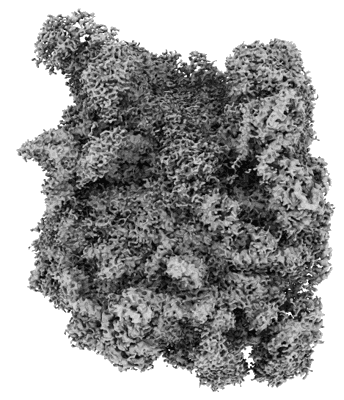EMD-34725
NPC-trapped pre-60S particle
EMD-34725
Single-particle2.64 Å
 Deposition: 12/11/2022
Deposition: 12/11/2022Map released: 12/04/2023
Last modified: 13/11/2024
Sample Organism:
Saccharomyces cerevisiae S288C
Sample: NPC-trapped pre-60S ribosome
Fitted models: 8hfr (Avg. Q-score: 0.574)
Deposition Authors: Li ZQ, Chen SJ, Sui SF
Sample: NPC-trapped pre-60S ribosome
Fitted models: 8hfr (Avg. Q-score: 0.574)
Deposition Authors: Li ZQ, Chen SJ, Sui SF

Nuclear export of pre-60S particles through the nuclear pore complex.
Li Z,
Chen S,
Zhao L,
Huang G  ,
Xu H,
Yang X,
Wang P
,
Xu H,
Yang X,
Wang P  ,
Gao N
,
Gao N  ,
Sui SF
,
Sui SF 
(2023) Nature , 618 , 411 - 418
 ,
Xu H,
Yang X,
Wang P
,
Xu H,
Yang X,
Wang P  ,
Gao N
,
Gao N  ,
Sui SF
,
Sui SF 
(2023) Nature , 618 , 411 - 418
Abstract:
The nuclear pore complex (NPC) is the bidirectional gate that mediates the exchange of macromolecules or their assemblies between nucleus and cytoplasm1-3. The assembly intermediates of the ribosomal subunits, pre-60S and pre-40S particles, are among the largest cargoes of the NPC and the export of these gigantic ribonucleoproteins requires numerous export factors4,5. Here we report the cryo-electron microscopy structure of native pre-60S particles trapped in the channel of yeast NPCs. In addition to known assembly factors, multiple factors with export functions are also included in the structure. These factors in general bind to either the flexible regions or subunit interface of the pre-60S particle, and virtually form many anchor sites for NPC binding. Through interactions with phenylalanine-glycine (FG) repeats from various nucleoporins of NPC, these factors collectively facilitate the passage of the pre-60S particle through the central FG repeat network of the NPC. Moreover, in silico analysis of the axial and radial distribution of pre-60S particles within the NPC shows that a single NPC can take up to four pre-60S particles simultaneously, and pre-60S particles are enriched in the inner ring regions close to the wall of the NPC with the solvent-exposed surface facing the centre of the nuclear pore. Our data suggest a translocation model for the export of pre-60S particles through the NPC.
The nuclear pore complex (NPC) is the bidirectional gate that mediates the exchange of macromolecules or their assemblies between nucleus and cytoplasm1-3. The assembly intermediates of the ribosomal subunits, pre-60S and pre-40S particles, are among the largest cargoes of the NPC and the export of these gigantic ribonucleoproteins requires numerous export factors4,5. Here we report the cryo-electron microscopy structure of native pre-60S particles trapped in the channel of yeast NPCs. In addition to known assembly factors, multiple factors with export functions are also included in the structure. These factors in general bind to either the flexible regions or subunit interface of the pre-60S particle, and virtually form many anchor sites for NPC binding. Through interactions with phenylalanine-glycine (FG) repeats from various nucleoporins of NPC, these factors collectively facilitate the passage of the pre-60S particle through the central FG repeat network of the NPC. Moreover, in silico analysis of the axial and radial distribution of pre-60S particles within the NPC shows that a single NPC can take up to four pre-60S particles simultaneously, and pre-60S particles are enriched in the inner ring regions close to the wall of the NPC with the solvent-exposed surface facing the centre of the nuclear pore. Our data suggest a translocation model for the export of pre-60S particles through the NPC.
